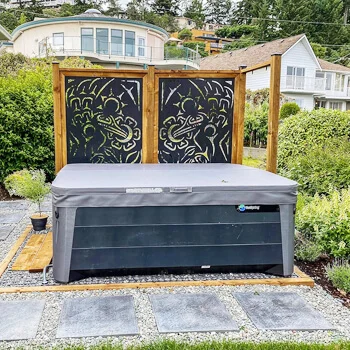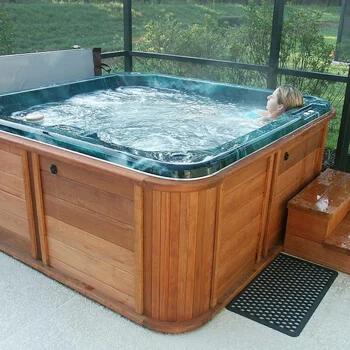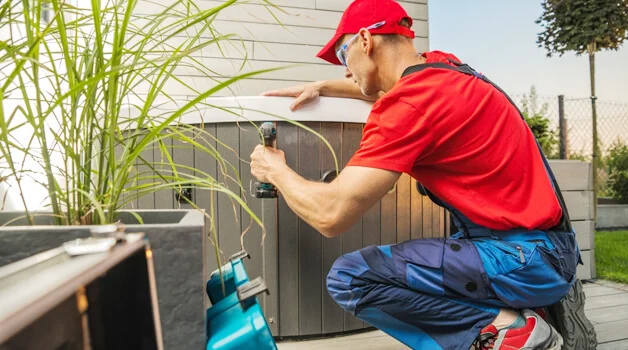When it comes to installing a hot tub, one of the most crucial decisions you’ll make is choosing the right base.
The foundation not only ensures the stability and longevity of your hot tub but also impacts its overall functionality and appearance.
I will give you 10 hot tub base ideas, along with some juicy information that is vital for hot tub base installation and maintenance in today’s piece.
Preparing the Ground for Your Hot Tub Base
Getting your ground ready for a hot tub base is very important for keeping your hot tub stable and lasting long. Here’s what you need to prepare the ground:
- Pick Your Spot: Find the right place for your hot tub. Think about how easy it is to get to, how private it is, and how it’ll look. Make sure it’s level and clear of stuff like rocks or roots.
- Check the Rules: Hit up your local council or homeowners’ group to see if there are any rules or permits you need for a hot tub.
- Clear the Ground: Get rid of any plants, rocks, or other things in the way where you’re putting the hot tub.
- Mark It Out: Use stakes and string to outline where your hot tub will go. Double-check the size to make sure it fits your tub.
- Dig It: If your base needs it, dig out a spot for it. How deep you go depends on what you’re using for the base and your local weather.
- Level the Ground: Use a level and a tamper to get the ground flat and firm. This stops your tub from leaning or sinking later on.
- Sort Out Drainage: Make sure water won’t pool around your tub. You might need to slope the ground a bit.
- Stop Weeds: Lay down some weed barrier cloth to keep weeds from popping up through your base.
- Put Down Your Base: Follow the instructions for your base type, like pouring concrete or building a deck.
- Expect Some Settling: If you’re using gravel or something similar, it might settle a bit over time. Keep an eye on it and add more if you need to.
- Double-check the Level: After everything’s settled, make sure it’s still level.
- Final Size Check: Make sure the base is the right size for your hot tub, with enough room around it for upkeep and getting in and out.
10 Types of Hot Tub Bases
After preparing the ground you can choose a hot tub base type of your choice. Choosing the right base for your hot tub is not just a matter of preference but also a question of practicality and safety. Here are 10 hot tub base ideas each with its unique characteristics:
1. Concrete Slabs

A concrete base is a popular choice for hot tubs due to its longevity and strength. It provides a solid and permanent foundation that can withstand the weight of the hot tub and its occupants. Typically, it’s a 4-inch thick concrete pad poured on a leveled and compacted surface. However, it’s essential to have it professionally installed to ensure proper leveling and reinforcement.
Benefits:
- Durability: Concrete slabs are strong and can easily support the weight of a hot tub filled with water and bathers.
- Low Maintenance: Once set, concrete requires minimal upkeep.
Considerations:
- Professional Installation Recommended: Pouring a concrete slab usually requires professional skills for leveling and finishing.
- Permanent: Once installed, it’s not easy to move.
2. Spa Pads

Prefabricated spa pads are interlocking grids made from durable plastic. They are convenient and relatively hassle-free to install. These pads often have built-in features like insulation and water drainage, enhancing their functionality.
Benefits:
- Easy Installation: Spa pads can be a DIY project and don’t require special tools.
- Portability: They can be disassembled and moved if needed.
Considerations:
- Surface Preparation: The ground must be level for proper support and stability.
- Weight Limitations: They may not be suitable for very large or heavy hot tubs.
3. Gravel Beds

Gravel and crushed stone bases are budget-friendly options that offer decent support and drainage. They are ideal for temporary hot tub setups or situations where you may need to move the hot tub in the future. Keep in mind that regular maintenance may be needed to ensure the base remains level and supportive.
Benefits:
- Drainage: Gravel allows for excellent drainage around the hot tub.
- Cost-Effective: Generally cheaper than concrete.
Considerations:
- Weed Barrier Needed: A weed barrier under the gravel is recommended to prevent growth.
- Regular Maintenance: This may require occasional leveling and weed removal.
4. Wooden Decks

A reinforced wooden deck can serve as a stylish and functional hot tub base. Wood deck bases offer a warm and inviting look for your hot tub area. They are a great option if you want to integrate your hot tub into an existing deck or create a seamless outdoor living space. However, they require ongoing maintenance to protect against weathering and decay.
Benefits:
- Aesthetics: Offers a natural, elegant look.
- Customizable: This can be designed to match your landscape and home.
Considerations:
- Strength and Support: Must be structurally reinforced to handle the weight.
- Regular Maintenance: Wood requires treatment and upkeep to prevent decay.
5. Reinforced Patios

Existing patios can be reinforced to support a hot tub, using materials like pavers or flagstone.
Benefits:
- Utilizes Existing Space: Ideal for integrating a hot tub into your current landscape.
- Variety of Designs: Wide range of styles and materials.
Considerations:
- Weight Capacity: Ensure the patio is structurally sound to support the hot tub.
- Professional Assessment Recommended: A structural engineer or contractor should evaluate the patio’s suitability.
6. Paver Stones

Paver stones offer a customizable and visually appealing option for hot tub bases. They come in various shapes, sizes, and colors, allowing for creative design choices. Paver stones are laid over a compacted sand and gravel base, providing stability and drainage.
Benefits:
- Aesthetic Appeal: Pavers offer a high degree of customization, enhancing the beauty of your outdoor space.
- Flexibility in Design: Can be arranged in various patterns to suit personal tastes.
Considerations:
- Leveling and Installation: Requires careful installation to ensure a level and stable surface.
- Maintenance: This may need periodic adjustment or re-leveling, especially in areas with freeze-thaw cycles.
7. Synthetic Spa Decks

Synthetic or composite materials are becoming popular for hot tub bases due to their durability and low maintenance. These materials mimic the look of wood but are resistant to rot, decay, and insect damage.
Benefits:
- Low Maintenance: Unlike natural wood, synthetic decks require minimal upkeep and are not prone to rot or decay.
- Longevity: Typically lasts longer than traditional wood decks.
Considerations:
- Cost: Generally more expensive than natural wood.
- Heat Sensitivity: Some synthetic materials can be sensitive to high temperatures and direct sunlight.
8. Elevated Platforms

For hot tubs that require a raised base, constructing an elevated platform can be an effective solution. This involves building a sturdy, raised structure, often made of wood or metal, to house the hot tub.
Benefits:
- View and Accessibility: Offers a great view and can be easier to access, especially in sloped areas.
- Customizable Height: The height can be adjusted to meet specific needs or preferences.
Considerations:
- Structural Integrity: Requires careful design and construction to ensure it can support the weight of the hot tub.
- Safety: Must include safety features like railings or steps.
9. Eco-Friendly Bases

Eco-friendly options like recycled rubber tiles or sustainable wood products are gaining popularity. These materials are environmentally friendly and offer a unique look for your hot tub base.
Benefits:
- Sustainability: Made from recycled or sustainable materials, reducing environmental impact.
- Unique Aesthetic: Offers a distinctive look different from traditional materials.
Considerations:
- Durability: Some eco-friendly materials may not be as durable as conventional options.
- Cost: Can be more expensive than traditional materials.
10. Artificial Grass or Turf

Artificial grass or turf can be used as a base for hot tubs, especially in areas where natural grass is difficult to maintain. It provides a soft, even surface and can be laid over a compacted base.
Benefits:
- Aesthetic Appeal: Offers a green, manicured look year-round.
- Low Maintenance: Does not require watering, mowing, or fertilizing.
Considerations:
- Underlayment: Requires a stable and well-drained underlayment to prevent sagging or unevenness.
- Heat Resistance: Some artificial turfs may not be suitable for high-temperature environments.
✨ You May like: Minimum Temperature For Hot Tub In Summer
DIY vs. Professional Installation

After deciding on hot tub base ideas, comes installation. The decision between DIY (Do It Yourself) and professional installation for your hot tub base is a significant consideration. Both options have their merits, and the choice ultimately depends on your level of expertise, available time, and budget. Let’s weigh the pros and cons of each:
DIY Installation
Pros:
- Cost Savings: DIY installation typically costs less than hiring professionals, as you won’t incur labor fees.
- Sense of Accomplishment: Successfully completing a DIY project can be personally rewarding.
- Customization: You have full control over the design and execution of your hot tub base.
- Flexibility: You can work on your own schedule and adapt to any changes as needed.
Cons:
- Skill Requirement: DIY installation requires basic construction skills, and mistakes can be costly to rectify.
- Time-Consuming: It may take longer to complete the installation, especially if you’re not experienced.
- Risk of Errors: Inaccurate leveling or improper base construction can lead to safety issues and costly repairs.
- Limited Warranty: Manufacturer warranties may not cover damage resulting from DIY installation.
Professional Installation
Pros:
- Expertise: Professionals have the experience and knowledge to ensure a proper and safe installation.
- Time Efficiency: Installation is typically completed faster, allowing you to enjoy your hot tub sooner.
- Warranty Protection: Many hot tub manufacturers require professional installation to maintain warranty coverage.
- Reduced Risk: Professional installers are less likely to make errors that could damage your hot tub.
Cons:
- Higher Cost: Professional installation can be more expensive due to labor and service fees.
- Limited Customization: You may have less control over the design and customization of your base.
- Scheduling: You’ll need to coordinate with the installation team, which may require some flexibility on your part.
Case Study: DIY Success
John Doe, a DIY enthusiast from Oregon, successfully built a gravel base for his hot tub. He chose a level spot in his backyard, framed a 10×10 area, and filled it with crushed gravel. After compacting and leveling the gravel, he placed his hot tub on the base. John reports that the base has been excellent in terms of stability and drainage, and he saved significantly on installation costs.
Quotes from Experts
“Building your own hot tub base can be a fulfilling project, but it’s crucial to prioritize structural integrity and safety,” says Jane Smith, a professional landscape architect. “Ensure that the base is perfectly level and capable of supporting the full weight of a filled hot tub.”
What Factors You Need To Consider
When you’re setting up a hot tub, there’s a bunch to think about to make sure it’s safe, lasts long, and looks good. Here are a few factors you should take into consideration when setting up your hot tub base:
- Weight Support: Hot tubs are heavy, especially when filled with water and people. Make sure your base can handle the heft without any trouble.
- Level and Stability: A wobbly base is a no-go. It can mess up your hot tub and even be unsafe. Keep things level and check it now and then.
- Drainage: You don’t want water pooling around your hot tub. Pick a spot with good drainage or work out a way to keep water away.
- Durability and Maintenance: Choose a base that can handle the weather and doesn’t need a ton of upkeep. If you’re going with wood, remember it’ll need some extra love to stay in shape.
- Aesthetics: Your hot tub should look like it belongs. Pick materials and styles that match your vibe and your yard.
- Cost: We all have budgets. Find a balance between not spending too much and getting a base that won’t let you down.
- Accessibility: Think about how you’ll get to and from your hot tub. You want a path that’s easy and safe.
- Local Regulations: Don’t forget to check the rules. Some places have specific do’s and don’ts for hot tubs, so make sure you’re in the clear.
Table: Comparison of Base Types
| Base Type | Weight Support | Durability | Maintenance | Aesthetics | Cost |
|---|---|---|---|---|---|
| Concrete Slab | Excellent | High | Low | Neutral | High |
| Spa Pads | Good | Moderate | Low | Good | Medium |
| Gravel Bed | Good | High | Medium | Good | Low |
| Wooden Deck | Variable | Moderate | High | Excellent | High |
| Reinforced Patio | Variable | High | Variable | Excellent | Variable |
| Paver Stones | Good | High | Medium | Excellent | Medium |
| Synthetic Spa Decks | Good | High | Low | Good | High |
| Elevated Platforms | Excellent | High | Medium | Good | High |
| Eco-Friendly Bases | Good | Variable | Low | Unique | High |
| Artificial Grass/Turf | Moderate | Moderate | Low | Excellent | Medium |
How To Maintain The Hot Tub Base
Maintaining your hot tub base is essential to ensure its longevity and the overall performance of your hot tub. Here are some key maintenance tips to keep in mind:
- Regular Cleaning: Periodically clean the hot tub base to remove dirt, debris, and leaves. Sweeping or using a leaf blower can help with this task. For wood decks, consider pressure washing to maintain its appearance.
- Inspect for Settling: If you have a base made of gravel or crushed stone, check for settling over time. Add more material as needed to maintain a level surface.
- Weed Control: Keep an eye out for weeds or vegetation trying to push through the base. Use weed barriers or landscaping fabric to prevent their growth.
- Sealing and Staining: For wood deck bases, reapply sealant or stain as needed to protect against moisture and UV damage.
- Address Drainage Issues: Ensure that the drainage around your hot tub is working correctly. Proper drainage prevents water from pooling around the base, which can lead to erosion and damage.
- Regularly Inspect for Damage: Check for cracks, rot, or other damage to your hot tub base. Early detection can prevent more significant problems down the road.
- Follow Manufacturer Recommendations: Adhere to any specific maintenance guidelines provided by the manufacturer of your hot tub base material.
- Winter Preparations: If you live in a region with cold winters, take steps to protect your base from freezing temperatures. For example, use de-icing salts carefully to prevent damage to concrete.
- Re-Level as Needed: Over time, especially with wood or gravel bases, you may need to re-level the surface to maintain stability. This is particularly important for the safety of your hot tub.
Final Thoughts
Choosing the right base for your hot tub isn’t just about practicality; it’s about creating your perfect backyard retreat. Whether it’s the sturdiness of concrete, the charm of wooden decks, or the eco-friendly touch of synthetic options, each base has its own vibe.
Remember, it’s not just a base; it’s the foundation of countless relaxing evenings and fun gatherings. So, pick one that suits your style, budget, and hot tub dreams. Happy soaking!
✨Next Attraction: Roll Up Hot Tub Cover Guide
I am Donald M. Beyer and I am backyard enthusiasts. I am a homeowner who has been doing DIY projects in and out of my house for many years. From simple backyard lunches to making an old-school pizza oven in my own backyard, I have a lot of experience in turning my backyard into my and my family’s personal playground.








